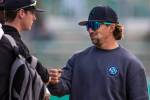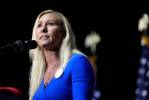Thomas Hull


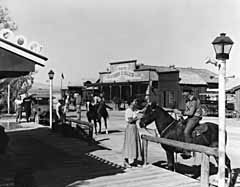
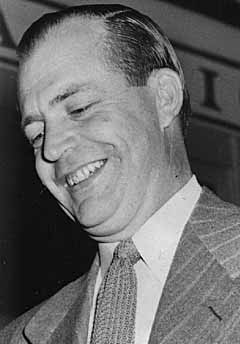
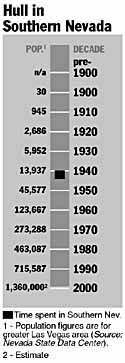
Even Fremont Street was dead in the wee morning hours in 1940. That’s why Tommy Hull and Jim Cashman found it feasible to have a few drinks on the sidewalk in front of the Apache Hotel. They fell to discussing opportunities that might be found along this street, which at the time was one of the few in America where gambling was actually legal.
Big Jim said, “What we really need here is a real resort,” or words to that effect.
The very next day, Big Jim claimed later, they were looking at sites big enough to build the kind of operation Hull wanted. Cashman, who was a sort of one-man chamber of commerce, suggested a tract at what is today Maryland Parkway and Sahara Avenue. “He said, I don’t want to build there,” Cashman told his son, James Jr. “I want to build on the road going into town.” Hull pointed at the corner of San Francisco Avenue and the Los Angeles Highway.
There’s a popular story that Hull selected that site because he once had a flat tire there and idly counted the cars that came by while he was waiting for a tow truck. He saw the traffic would support a roadside resort. There’s still another story that the main reason he picked the site was that it was owned by a single individual, with no partners, so the deal to buy it could be closed quickly.
Whatever his reasons, his decision put Las Vegas in the resort business and determined there would be a Las Vegas Strip. The Strip started with his hotel both chronologically and geographically, for the resort corridor took shape from his resort south.
Tommy Hull was not afraid to take chances. He was an adventurer and plunger who had risked both his life and his fortune when occasion demanded. Born in Colorado Springs on Oct. 3, 1893, he graduated from the Colorado Agricultural and Mining College in 1913. Hull then tried to ply his mining trade in Mexico but ran into trouble in those revolutionary times, and walked 600 miles back to safety.
He ran a movie theater in New Mexico but was unsuccessful. During World War I he became an officer and a flight instructor for the Army. Following the war he tried running movie theaters in Austin, Texas. Hull sold his operations to a larger corporation at a profit, then joined his father in the hotel business in San Francisco. He eventually acquired the Bellevue in San Francisco, and traded upon his own background as a pilot to make it a gathering spot for America’s first generation of aviation heroes, such as Charles Lindbergh, Eddie Rickenbacker, Wiley Post and Clyde Pangborn.
In September 1932, he took over Los Angeles’ Mayfair, soon adding Hollywood’s Roosevelt and the Hotel Senator in Sacramento, Calif. By the time he started the venture in Las Vegas, there were eight other hotels under his management.
One of his innovations was extending the services and ambience of first-class hotels into motels and auto courts, places where luxury had been previously unseen. He dubbed each of his new auto hotels “El Rancho,” and the one in Las Vegas, opened April 3, 1941, was his third.
Hull figured one of the main functions of the Las Vegas version would be to offer refreshment and rest to travelers on the hot journey from Los Angeles to Salt Lake City. A key attraction was a swimming pool built only a few feet from the highway.
His original plan didn’t even call for a casino, according to the late John Cahlan, who was managing editor of the Review-Journal when Hull arrived. In an oral history interview done for the University of Nevada, Reno, Cahlan said, “When he started his motel, several of his friends that he had made here in Las Vegas … said, ‘Why don’t you build a casino building?’ ”
The casino and a small dining room, surrounded by 65 guest cottages, constituted El Rancho Vegas.
“The dining room was built sort of in the form of a corral, with the dance floor being the center of the corral,” remembered Cahlan. Walls were brick and the ceiling had open wood beams, and chandeliers made out of wagon wheels. There was a wishing well against one wall. Each table was lit by a hurricane lamp with a leather lampshade; chairs were also of stitched leather.
Entertainment director Maxine Lewis “set the tempo … for the acts that were in use up until 1960,” recalled Cahlan. “She would have a singer, a standing comedian, and then the star of the show with dance girls.”
One of the first bands to play El Rancho was Garwood Van’s. The leader settled in and spent the rest of his life here, founding a local music company.
Las Vegans booked the dining room for wedding parties and banquets. “They’d been waiting for a resort hotel for 40 years, and they thought that this was the best offer that they’d had, and they greeted it very well,” said Cahlan. “But they were skeptical, because it was clear out of town.”
There was so much business, however, that even celebrities couldn’t always get a table. Garwood Van told Las Vegas writer George Stamos about an evening that movie star Wallace Beery and his family were denied a table.
“I don’t want to see no goddamned show, I just want to have dinner,” roared Beery. Van, who by that time had acquired some authority beyond his role as a bandleader, had a table set up for the family at poolside, converting an unavoidable snub into a memorable evening for the Beery family.
Tommy Hull was the man who decided that Las Vegas wouldn’t be a black-tie-only resort. On opening night many Las Vegans wore formal evening wear. Hull showed up in jeans, boots, cowboy shirt. By now an urbane sophisticate, he reverted to his native Western drawl, and according to newspaper reports, repeatedly uttered the words which became a motto: “Come as you are.”
Hull hadn’t been open long when another Western-style casino would try to rustle some of the patrons from El Rancho. R.E. Griffith, who had built and run a chain of movie theaters in the South, and his nephew and architect William J. Moore, were thinking of expanding into the hotel business in Deming, N.M. In connection with that venture they made a business trip to Los Angeles, came through Las Vegas on their way home, and were so impressed that they immediately changed their plans.
In one of the coincidences of history which seem to defy mathematical odds, Griffith and Moore had planned to name their new hotel El Rancho, long before they had heard of one by that name in Las Vegas. Finding one already open with that name, they settled on The Last Frontier. And like Hull, they chose to operate south of town on the Los Angeles Highway.
In 1982 Moore was interviewed for The Pioneer Tapes, an oral history project sponsored jointly by UNLV, the Nevada Humanities Committee, and the Las Vegas Review-Journal. Arriving in December 1941, Moore told a UNLV oral historian, Moore and Griffith had the poor timing to be building a hotel during World War II, when construction materials were hard to get and hard to keep. Construction was supposed to be limited to projects for the war effort.
“They exempted anybody that had started construction … providing they could prove that they had the material before the institution of the War Production Board,” he told the UNLV interviewer. Moore’s group proved it, but then ran into a catch: The board also had authority to seize materials for the war effort. Proving they had the materials handed the government a list of what was available to commandeer.
“So they came in on our construction job at the hotel and essentially grabbed all of the material we had having to do with anything electrical and took the material in trucks to the Army air base.”
Moore solved that problem by buying a couple of mines and stripping the wire and conduit out of them. To avoid wasting material he incorporated an existing roadhouse and casino, formerly the Pair-O-Dice but then known as the 91 Club, into The Last Frontier. He bought a bar and the barroom entrance out of the historic Arizona Club in Las Vegas’ old Block 16 red-light district, and used them in the new hotel.
The shortages of building material forced Griffith and Moore to reuse and preserve some of the historic buildings of Southern Nevada. They managed to build a 100-room resort, slightly smaller than their original intention.
Moore and Griffith opened their hotel on Dec. 10, 1942, but their strange home-front war wasn’t over. Rationing made it hard to get food for the hotel dining room, so The Last Frontier bought ranches and raised its own cattle for meat and milk. Las Vegas war babies were raised partly on the surplus, sold to the public.
Griffith and Moore were experienced promoters who had helped build the theater business to the dominance it enjoyed in the 1940s, when many Americans attended movies three or four times a week. They used their connections in that business to bring in stars to entertain their resort’s visitors. Tommy Hull had no such connections, so he raided their stable of performers to supply his own showroom, often offering the stars twice the salary they were making at The Last Frontier.
“We were creating jobs, yes. But we were also in the position of furnishing our own competition,” said Moore. “We had no alternative.”
Griffith died less than a year after the hotel opened. It was Moore who carried out the dream, often attributed to Griffith, of establishing the Frontier Village, celebrating Nevada’s colorful past. This was no hokey heap of used sets from forgotten B-movies, but consisted largely of the actual buildings and relics of Nevada’s yesteryears.
Most of it came from the collection of Robert “Dobie Doc” Caudill, Moore said.
“Dobie Doc” was an abbreviation of the name under which he had once run a construction-repair business: The Adobe Doctor. Caudill was a gambler who would later hold a small interest in Benny Binion’s Horseshoe Casino. He was also a compulsive collector of Western memorabilia; so compulsive, in fact, that many called him a kleptomaniac.
It is uncertain whether the Frontier management understood the doubtfulness of title by which Doc held many of his collectibles. But those it bought from him and displayed included Elko’s joss house — a small temple built for Chinese railroad workers in the 1860s and said to be the oldest surviving in the United States. There was the wooden jail which served Tuscarora in the 1870s. Its interior walls were still equipped with leg irons, and charred by an escape-by-fire plot which went awry and burned to death the man trying to escape. There were real prairie schooners, real old-fashioned horse-drawn fire engines.
Under Moore the Frontier ran some of the first junkets, booking the planes through an obscure airline operator named Kirk Kerkorian.
Well established before Benjamin “Bugsy” Siegel began building the Flamingo in 1946, Moore stood up to the reputed killer when he tried to throw his weight around Las Vegas. About 1980 Moore related to Review-Journal gaming reporter Clyde Weiss how Siegel became enraged at some imagined offense by the Frontier against his new resort, the Flamingo. He responded by sending in his goons with bottles of acid, which they dripped up and down the Frontier hallways onto the carpet.
A summit meeting was called and Siegel showed, guarded by some cronies wearing size-19 collars and size-6 hats. But Moore brought some of his own dealers, and Siegel quickly perceived that while Moore was a college boy, some of Moore’s employees had been instructors in the school of hard knocks.
Siegel paid for the carpet, Moore claimed, and made no more trouble in Las Vegas.
Siegel died soon thereafter of a .30-caliber bullet through the brain precipitated by his mismanagement of the Flamingo for his silent partners.
“It became obvious to those of us who had been in business here in town that, if somebody didn’t get control of this business, sooner or later there was going to be no business,” Moore said. In some Nevada counties, said Moore, the way to get a gaming license was already to bribe the sheriff, and human nature directed this would sooner or later become the case in Las Vegas.
Even the mob-front guys who succeeded Siegel, said Moore, saw that this trend would quickly wreck the gravy train and supported Moore’s idea of getting the Nevada Tax Commission to take over gaming licensing. The Tax Commission agreed on condition Moore accepted an appointment to the commission.
By this time, Tommy Hull was long gone from the Strip he started. The conventional wisdom said his unexpected sale of the El Rancho in June 1943 was precipitated by fear of competing with the competent Bill Moore.
But John Cahlan discounted that story. “I think he kind of welcomed the competition,” said Cahlan. And Hull would be back, for a while, as a partner in the Flamingo. He died in 1964 at his home in Beverly Hills of a heart attack at the age of 70. El Rancho burned in 1960.
Moore left the Frontier in 1951, when major stockholders decided to sell the hotel. He would rejuvenate downtown’s El Cortez hotel and build the Showboat on Boulder Highway before drifting out of the resort business into real estate development, oil drilling and, improbably, pioneering the potato agribusiness in northwestern Nevada. He died in 1982 at the age of 68, still a Las Vegas resident.
Both had gone on to make many another mark, but during the war years , Hull and Moore were inventing the Las Vegas Strip.
Part I: The Early Years
Part II: Resort Rising
Part III: A City In Full



